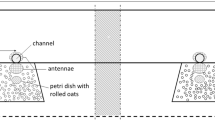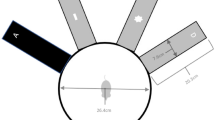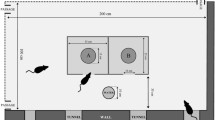Abstract
The effectiveness of predator odors (fecal, urine, and anal scent gland) in suppressing feeding damage by snowshoe hares was investigated in pen bioassays at the University of British Columbia Research Forest, Maple Ridge, British Columbia, Canada. A total of 28 bioassay trials tested the effects of these odors on hare consumption of willow browse and coniferous seedlings. Lynx and bobcat feces, weasel anal gland secretion, and lynx, bobcat, wolf, coyote, fox, and wolverine urines resulted in the most effective suppression of hare feeding damage. Novel odors of domestic dog urine and 2-methylbutyric acid did not reduce feeding. A field bioassay with lodgepole pine seedlings and weasel scent provided significant results comparable to the pen bioassays. The short-term (up to seven days) effectiveness of these treatments was more likely due to evaporative loss of the active repellent components of a given odor than habituation of hares to the stimulus. Predator odors as repellents have a biological basis compared with the anthropomorphic origins of commercial repellents. When encapsulated in weather-proof controlled-release devices, these odors could provide long-term protection for forestry plantations and agricultural crops which experience hare/rabbit feeding damage.
Similar content being viewed by others
References
Albone, E.S., Eglinton, G., Walker, J.M., andWare, G.C. 1974. The anal sac secretion of the red fox (Vulpes vulpes); its chemistry and microbiology. A comparison with the anal sac secretion of the lion, (Panthera leo).Life Sci. 14:387–400.
Albone, E.S., andPerry, G.L. 1976. Anal sac secretion of the red fox,Vulpes vulpes; volatile fatty acids and amines: Implications for a fermentation hypothesis.J. Chem. Ecol. 2:101–111.
Banfield, A.W.F. 1974. The Mammals of Canada. University of Toronto Press, Ontario.
Bolles, R.C. 1970. Species-specific defense reactions and avoidance learning.Psychol. Rev. 77:32–48.
Boonstra, R., Rodd, F.H., andCarleton, D.J. 1982. Effect ofBlarina brevicauda on trap response ofMicrotus pennsylvanicus.Can. J. Zool. 60:438–442.
Brand, C.J., andKeith, L.B. 1979. Lynx demography during a snowshoe hare decline in Alberta.J. Wildl. Manage. 43:827–849.
Bronson, F.H. 1971. Rodent pheromones.Biol. Reprod. 4:344–357.
Brown, W.L., Eisner, T., andWhittaker, R.H. 1970. Allomones and kairomones, transspecific chemical messengers.Bioscience 20:21–22.
Bullard, R.W., andShumake, S.A. 1977. Food base flavour additive improves bait acceptance by ricefield rats.J. Wildl. Manage. 41:290–297.
Cattarelli, M., andChanel, R. 1979. Influence of some biologically meaningful odorants on the vigilance states of the rat.Physiol. Behav. 23:831–838.
Chael, M.L., andSprott, R.L. 1971. Social olfaction: A review of the role of olfaction in a variety of animal behaviors.Psychol. Rep. 29:195–243.
Christiansen, E., andDoving, K. 1975. Pheromones in small rodents, pp. 221–227,in L. Hansson and B. Nilsson (eds.). Occurrence and Supposed Usefulness in Biological Control. Biocontrol of Rodents. Swedish Natural Science Research Council, Ecological Bulletin No. 19.
Crump, D.R. 1978. 2-Propylthietane, a major malodorous substance from the anal gland of the stoat (Mustela erminea).Tetrahedron Lett. 52:5233–5234.
Crump, D.R. 1980. Thietanes and dithiolanes from the anal gland of the stoat (Mustela erminea).J. Chem. Ecol. 6:341–347.
Dodge, W.E., Loveless, C.M., andKverno, N.B. 1967. Design and analysis of forest-mammal repellent tests.For. Sci. 13:333–336.
Eisenberg, J.F., andKleiman, D.G. 1972. Olfactory communication in mammals.Annu. Rev. Ecol. Syst. 3:1–32.
Henessy, D.F., andOwings, D.H. 1978. Snake species discrimination and the role of olfactory cues in the snake-directed behavior of the California ground squirrel.Behaviour 65:116–124.
Hinde, R.A., andStevenson-Hinde, J. 1973. Constraints on Learning. Academic Press, London.
Keith, L.B., andWindberg, L. A. 1978. A demographic analysis of the snowshoe hare cycle.Wildl. Monogr. 58.
Krajina, V.J. 1969. Ecology of forest trees in British Columbia.Ecol. West. North Am. 2:1–147.
Lehner, P.N., Krumm, R., andCringan, A.T. 1976. Tests for olfactory repellents for coyotes and dogs.J. Wildl. Manage. 40:145–150.
Lichtenstein, P.E. 1950. Studies of anxiety: I. The production of a feeding inhibition in dogs.J. Comp. Physiol. Psychol. 43:16–29.
Lockley, R.M. 1964. The Private Life of the Rabbit. Transworld, London.
Mech, D.L. 1977. Wolf pack buffer zones as prey reservoirs.Science 198:320–321.
Mech, D.L., andPeters, R.P. 1977. The study of chemical communication in free-ranging mammals, pp. 321–332,in D. Muller-Schwarze and M. Mozell (eds.). Chemical Signals in Vertebrates. Plenum Press, New York.
Müller-Schwarze, D. 1972. Responses of young black-tailed deer to predator odors.J. Mammal. 53:393–394.
Müller-Schwarze, D. 1974. Olfactory recognition of species, groups, individuals and physiological states among mammals, pp. 316–326,in M.C. Birch (ed.). Pheromones. North Holland, Amsterdam.
Müller-Schwarze, D. 1983. Scent glands in mammals and their functions, pp. 150–197,in J.F. Eisenberg and D.G. Kleiman (eds.). Advances in the Study of Mammalian Behavior. Special Publication No. 7, American Society of Mammalogists.
Preti, G., Muetterties, E.L., Fruman, J., Kenelly, J.J., andJohns, B.E. 1976. Volatile constituents of dog (Canis familiaris) and coyote (Canis latrans) anal sacs.J. Chem. Ecol. 2:177–187.
Ralls, K. 1971. Mammalian scent marking.Science 171:443–449.
Rogers, L.L., Mech, L.D., Dawson, D.K., Peek, J.M., andKorb, M. 1980. Deer distribution in relation to wolf pack territory edges.J. Wildl. Manage. 44:253–258.
Seward, J.P., andRaskin, D.C. 1960. The role of fear in aversive behavior.J. Comp. Physiol. Psychol. 53:328–335.
Shumake, A.A. 1977. The search for applications of chemical signals in wildlife management, pp. 357–376,in D. Müller-Schwarze and M. Mozell (eds.). Chemical Signals in Vertebrates. Plenum Press, New York.
Solomon, R.L., andWynne, L.C. 1953. Traumatic avoidance learning: Acquisition in normal dogs.Psychol. Monogr. 67:1–19.
Stoddart, D.M. 1976. Effect of the odour of weasels (Mustela nivalis L.) on trapped samples of their prey.Oecologia 22:439–441.
Stoddart, D.M. 1980a. The Ecology of Vertebrate Olfaction. Chapman and Hall, London.
Stoddart, D.M. 1980b. Some responses of a free-living community of rodents to the odors of predators, pp. 1–10,in D. Müller-Schwarze and B.M. Silverstein (eds.). Chemical Signals: Vertebrates and Aquatic Invertebrates. Plenum Publishing, New York.
Stoddart, D.M. 1982. Does trap odor influence estimation of population size of the short-tailed vole,Microtus agrestis?J. Anim. Ecol. 51:375–386.
Sullivan, T.P. 1984. Effects of snowshoe hare damage on juvenile lodgepole pine—implications for spacing natural stands. Research Branch, British Columbia Ministry of Forests, Victoria. Research Note. 94. p. 27.
Sullivan, T.P., andCrump, D.R. 1984. Influence of mustelid scent gland compounds on suppression of feeding by snowshoe hares (Lepus americanus).J. Chem. Ecol. 10:1809–1821.
Sullivan, T.P., andSullivan, D-S. 1982. Barking damage by snowshoe hares and red squirrels in lodgepole pine stands in central British Columbia.Can. J. For. Res. 12:443–448.
Todd, A.W., Keith, L.B., andFischer, C.A. 1981. Population ecology of coyotes during a fluctuation of snowshoe hares.J. Wildl. Manage. 45:629–640.
Whittaker, R.H., andFeeny, P.P. 1971. Allelochemics: Chemical interaction between species.Science 171:757–770.
Vernet-Maury, E., Polak, E.H., andDemael, A. 1984. Structure-activity relationship of stressinducing odorants in the rat.J. Chem. Ecol. 10:1007–1018.
Author information
Authors and Affiliations
Rights and permissions
About this article
Cite this article
Sullivan, T.P., Nordstrom, L.O. & Sullivan, D.S. Use of predator odors as repellents to reduce feeding damage by herbivores. J Chem Ecol 11, 903–919 (1985). https://doi.org/10.1007/BF01012077
Received:
Accepted:
Issue Date:
DOI: https://doi.org/10.1007/BF01012077




